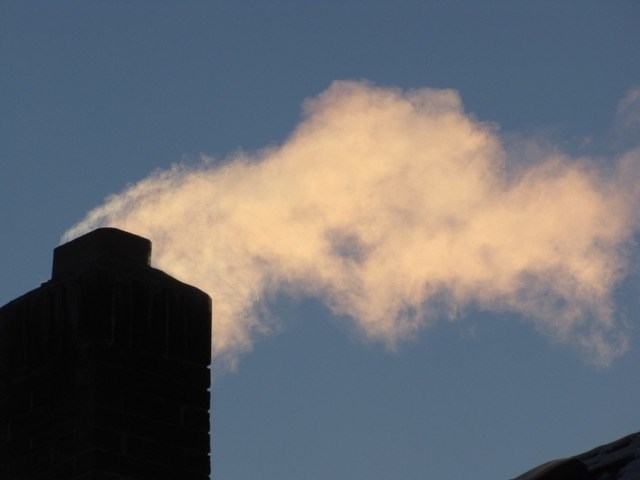
Image Credit: Contributed/RDCO
January 16, 2017 - 2:07 PM
Many wood stoves and fireplace inserts likely received a workout with the recent cold temperatures in the Central Okanagan.
The Regional Air Quality Wood Stove Exchange Program could help homeowners with wood burning appliances save some money while burning more efficiently and creating less pollution.
With funding from the BC Ministry of Environment in partnership with the BC Lung Association, the Air Quality program is again offering a $250 rebate (while funds last) for people replacing and recycling their old wood burning appliance with a new cleaner burning EPA/CSA certified appliance (wood, pellet, electric or gas burning hearth product). Participating Central Okanagan retailers will take care of recycling your old stove and provide all the necessary paperwork for the rebate.
Many valley homes have inefficient conventional wood stoves or heat their homes with open hearth fireplaces. Air Quality Coordinator Nancy Mora Castro says “If homeowners replaced those with a newer, cleaner-burning certified technology appliance they could burn a third less wood while cutting smoke emissions by up to 90%.”
From November 2015 to April 2016 the Air Quality program lead a study to identify possible hot spots of Fine Particulate Matter (PM2.5 – airborne particles with a mass median diameter less than 2.5 microns) across the Central Okanagan and found there were several areas that consistently had higher PM2.5 values than surrounding areas. (View the study and Clean Air Strategy at http://www.regionaldistrict.com/your-services/air-quality-program.aspx#Strategy)
She adds, “Through this new study, we identified certain neighbourhoods in Rutland, the upper Mission and Woodsdale area of Lake Country that consistently reached unhealthy levels of PM2.5 pollutants, due to smoke from wood stoves or emissions from vehicles. They would benefit if older, polluting wood burning appliances were replaced with newer models. Research has shown that there is no healthy threshold for smoke emissions. We breathe these microscopic particles into our lungs which can lead to respiratory conditions like asthma, bronchitis, emphysema and various forms of heart disease.”
In addition to the $250 Wood Stove Exchange program rebate, during March and April participating retailers may offer an additional rebates of $150 or more off the suggested retail price of new wood burning appliances. Some retailers may extend the additional rebates, so be sure to check with your local retailer for more information. To take part in the program, visit one of the participating Central Okanagan retailers, or contact the Regional Air Quality Program for more information. A list of participating retailers can be found at regionaldistrict.com/airquality.
Minimize Pollution from your wood burning appliance by following these simple steps:
-
Firewood should be seasoned by splitting and stacking it at least eight months before it is burned. Your woodpile should be covered in a way that keeps rain and snow off but allows air to circulate through it. Dry seasoned wood burns best!
-
Burn only clean, dry wood in your wood stove. Never burn green, wet, painted or treated wood including plywood, pressboard, railway ties or utility poles. Never burn household garbage in your wood stove or fireplace!
-
Burn only small bright fires. Start the fire using small pieces of wood kindling, and keep the fire moderately hot, adding larger pieces of split wood as required. Do not damper down the fire too much, as this will produce a smoky, oxygen-starved fire.
-
Watch for signs of incomplete burning such as visible smoke coming from your chimney or long, lazy flames in the firebox. When you see these signs, more air is needed to improve your fire. You must open the dampers to allow additional air into the stove.
-
Don't burn on fair or poor air quality days. Your wood smoke will add significantly to the problem, particularly on days of atmospheric inversions and still winds. View the current burning conditions at www.regionaldistrict.com/airquality
-
Buy the right stoves for your needs. The most common mistake is choosing a stove too large for the area to be heated. A stove that is too large for your home will have to be dampered-down to maintain a comfortable temperature, thus creating smoke and increasing air pollution.
-
Don't burn in moderate temperatures. Save your wood for cold days. When you do use your wood stove or fireplace, keep the fire small and bright and only burn clean, dry wood.
-
Don't damper down your fire, as this will produce a smoky, oxygen-starved fire. Ensure that you follow the manufacturer's instructions for the safe operation and maintenance of your particular stove.
-
Check your chimney frequently for creosote buildup: a common cause of house fires.
-
Have your stove and chimney inspected and cleaned by a professional every yearbefore the burning season.
View instructional videos and information on wood heating at: www.regionaldistrict.com/airquality
FYI contains information submitted from the public and is displayed exactly as it was received. Information is clearly attributed in bylines and not created by iNFOnews.ca staff. For more information, please contact the referring organization. If you have questions about FYI, or would like to submit information to FYI, please send directly to fyi@infonews.ca.
News from © iNFOnews, 2017